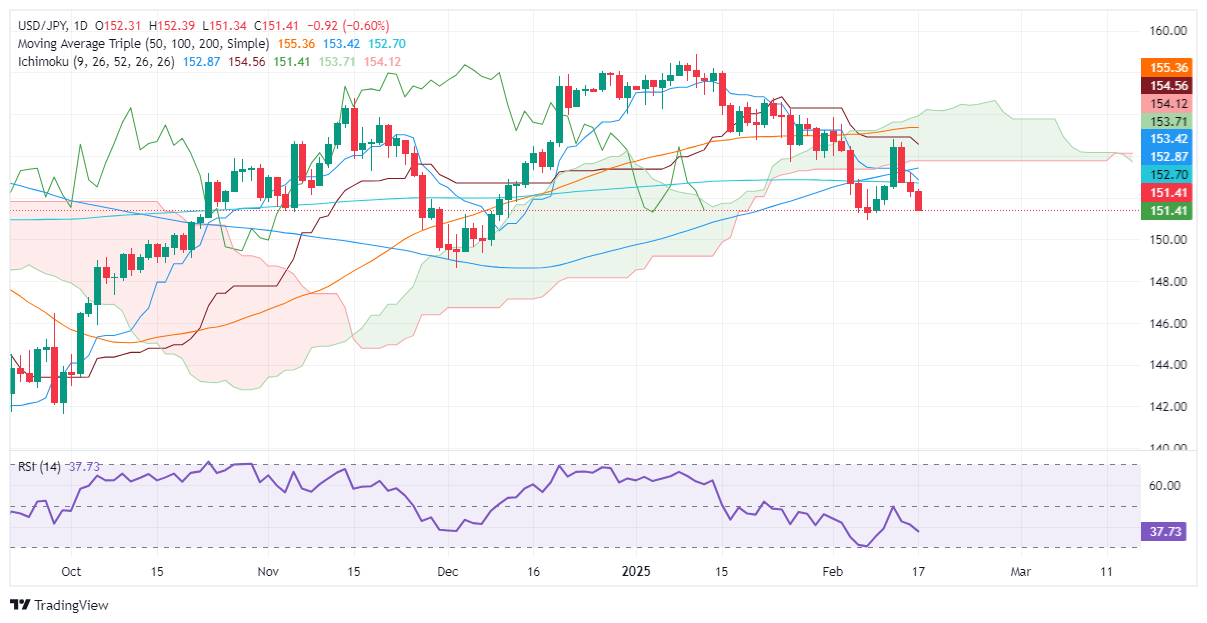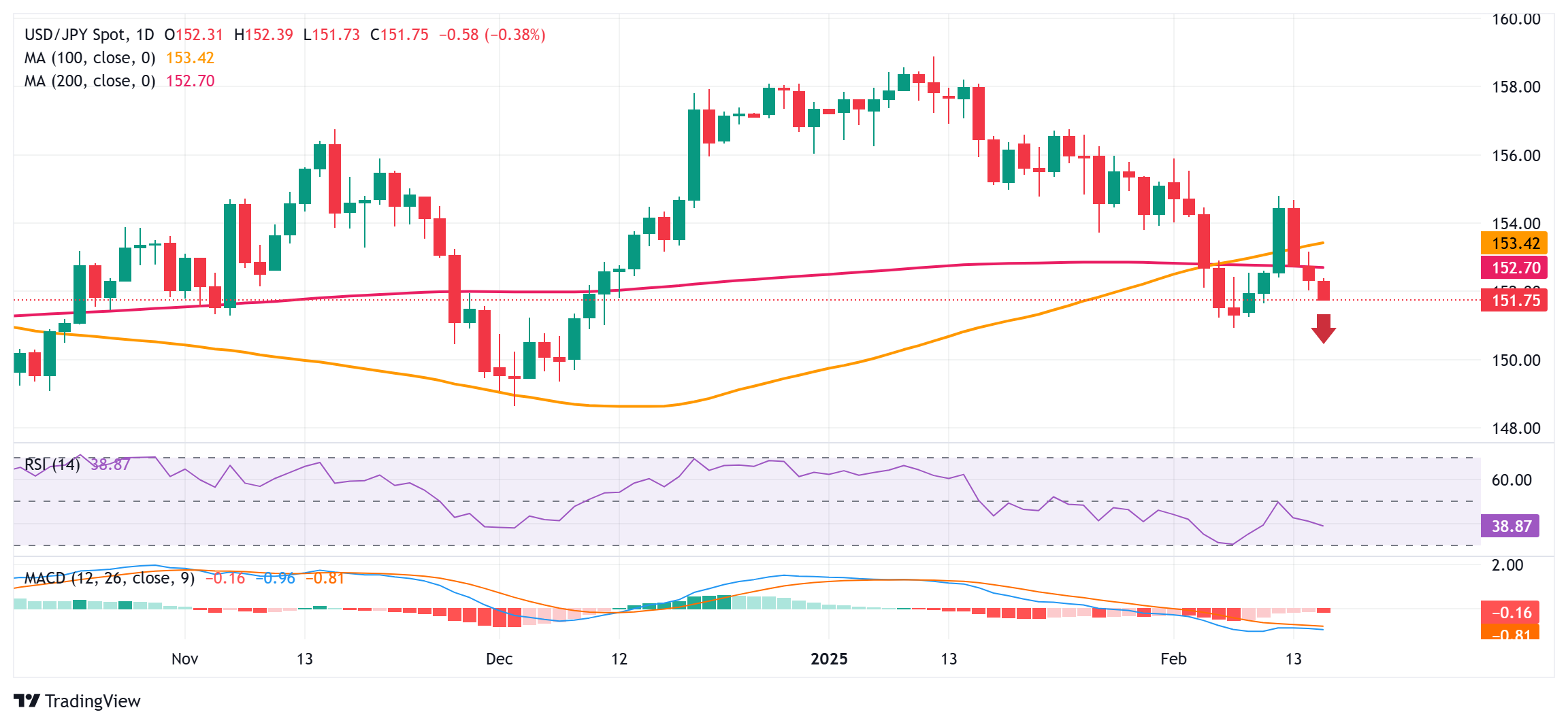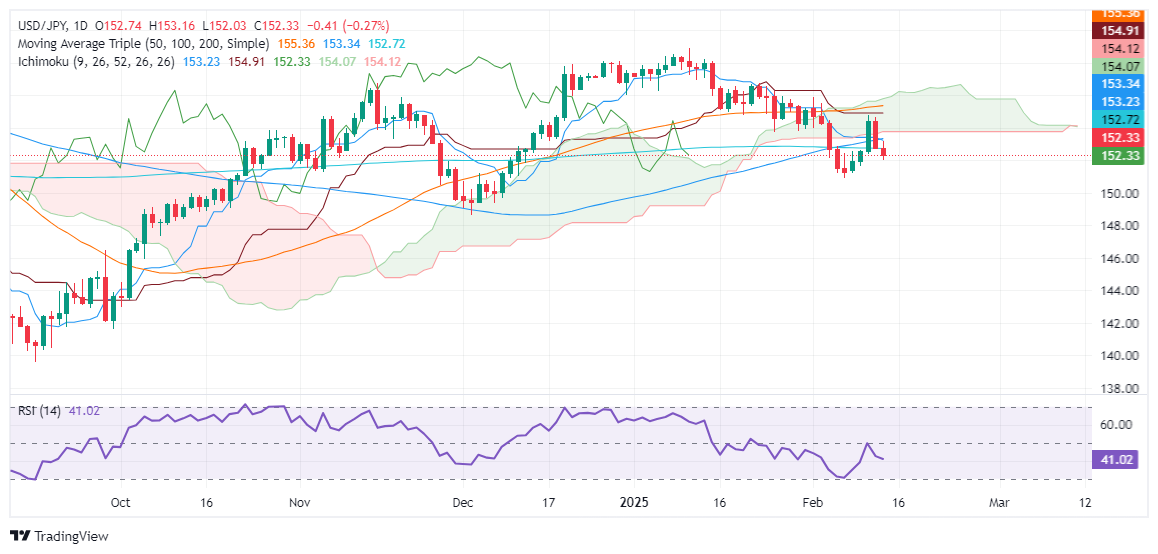- Analytics
- News and Tools
- Quotes
- Chart and quotes for USDJPY
CFD Trading Rate US Dollar vs Japanese Yen (USDJPY)
| Date | Rate | Change |
|---|
Related news
-
24.02.2025 13:34USD/JPY aims to extend upside to near 150.00 as Yen weakens across the board
- USD/JPY jumps to near 149.80 as the Japanese Yen weakens on a slight correction in 10-year JGBs.
- The BoJ is expected to raise interest rates further this year.
- The US Dollar bounces back as investors digest weak US PMI data.
The USD/JPY pair advances to near 149.80 in North American trading hours on Monday. The asset gains as the Japanese Yen (JPY) weakens across the board amid a slight correction in 10-year Japan bond yields.
Japanese Yen PRICE Today
The table below shows the percentage change of Japanese Yen (JPY) against listed major currencies today. Japanese Yen was the strongest against the Swiss Franc.
USD EUR GBP JPY CAD AUD NZD CHF USD -0.09% -0.11% 0.34% -0.05% -0.22% -0.15% 0.10% EUR 0.09% -0.11% 0.28% -0.15% -0.14% -0.24% 0.02% GBP 0.11% 0.11% 0.44% -0.04% -0.04% -0.14% 0.12% JPY -0.34% -0.28% -0.44% -0.39% -0.48% -0.41% -0.15% CAD 0.05% 0.15% 0.04% 0.39% -0.23% -0.10% 0.17% AUD 0.22% 0.14% 0.04% 0.48% 0.23% -0.10% 0.16% NZD 0.15% 0.24% 0.14% 0.41% 0.10% 0.10% 0.26% CHF -0.10% -0.02% -0.12% 0.15% -0.17% -0.16% -0.26% The heat map shows percentage changes of major currencies against each other. The base currency is picked from the left column, while the quote currency is picked from the top row. For example, if you pick the Japanese Yen from the left column and move along the horizontal line to the US Dollar, the percentage change displayed in the box will represent JPY (base)/USD (quote).
Investors rushed to buy Japanese bonds after Bank of Japan (BoJ) Governor Kazuo Ueda said on Friday that the central bank could ramp up the government bond-purchasing program if long-term interest rates rise sharply. 10-year JGBs decline to near 1.41% from 1.45%, the highest level seen in almost 15 years.
Meanwhile, firm expectations that the BoJ will raise interest rates again this year would keep the Japanese Yen on the front foot. Hotter-than-expected Japan’s National Consumer Price Index (CPI) data for January also added to expectations that the BoJ will tighten its monetary policy further.
On the US Dollar (USD) front, a strong recovery has been seen after sliding to its lowest in almost 12 weeks. The US Dollar Index (DXY) rebounded to near 106.60 as investors digest weak United States (US) flash S&P Global Purchasing Managers’ Index (PMI) data for February, released on Friday. The Composite PMI fell to 50.4 from 52.7 in January as activities in the services sector declined unexpectedly for the first time after expanding for straight 25 months.
Weak US private business activity data has resulted in a decent increase in Federal Reserve (Fed) dovish bets. The likelihood for the Fed to cut interest rates in the June meeting has increased to 58% from almost 50% a week ago, according to the CME FedWatch tool.
Japanese Yen FAQs
The Japanese Yen (JPY) is one of the world’s most traded currencies. Its value is broadly determined by the performance of the Japanese economy, but more specifically by the Bank of Japan’s policy, the differential between Japanese and US bond yields, or risk sentiment among traders, among other factors.
One of the Bank of Japan’s mandates is currency control, so its moves are key for the Yen. The BoJ has directly intervened in currency markets sometimes, generally to lower the value of the Yen, although it refrains from doing it often due to political concerns of its main trading partners. The BoJ ultra-loose monetary policy between 2013 and 2024 caused the Yen to depreciate against its main currency peers due to an increasing policy divergence between the Bank of Japan and other main central banks. More recently, the gradually unwinding of this ultra-loose policy has given some support to the Yen.
Over the last decade, the BoJ’s stance of sticking to ultra-loose monetary policy has led to a widening policy divergence with other central banks, particularly with the US Federal Reserve. This supported a widening of the differential between the 10-year US and Japanese bonds, which favored the US Dollar against the Japanese Yen. The BoJ decision in 2024 to gradually abandon the ultra-loose policy, coupled with interest-rate cuts in other major central banks, is narrowing this differential.
The Japanese Yen is often seen as a safe-haven investment. This means that in times of market stress, investors are more likely to put their money in the Japanese currency due to its supposed reliability and stability. Turbulent times are likely to strengthen the Yen’s value against other currencies seen as more risky to invest in.
-
24.02.2025 11:28USD/JPY: To retest the 148.90 level – UOB Group
-
21.02.2025 11:28USD/JPY: Expected to trade in a 149.20/150.55 range – UOB Group
-
21.02.2025 10:56USD/JPY: Technical rebound; fade rallies – OCBC
-
20.02.2025 02:23Japanese Yen buying remains unabated; USD/JPY dives to mid-150.00s
-
19.02.2025 13:23USD/JPY ticks lower to near 151.90 despite some strength in US Dollar
-
19.02.2025 11:06USD/JPY: Likely to consolidate for the time being – OCBC
-
19.02.2025 10:57USD/JPY: Tentative buildup in downward momentum – UOB Group
-
18.02.2025 14:58USD/JPY to trade at 145.00 in the end of the year – Rabobank
-
18.02.2025 09:56USD/JPY: To consolidate on the day – OCBC
-
18.02.2025 09:47USD/JPY: Can edge below 151.00 – UOB Group
-
17.02.2025 20:53USD/JPY Price Forecast: Slips below 152.00 as bearish momentum builds
-
17.02.2025 14:36USD/JPY slides to near 151.50 as Japanese Yen strengthens on robust GDP growth
-
17.02.2025 11:24USD/JPY: Unlikely to reach the major support at 151.00 – UOB Group
-
17.02.2025 10:41USD/JPY: Lower on BoJ hike prospects – OCBC
-
17.02.2025 02:33Japanese Yen builds on upbeat GDP-inspired gains; USD/JPY slides further below 152.00
-
14.02.2025 21:14USD/JPY Price Forecast: Sinks below 200-day SMA as USD tumbles
-
14.02.2025 11:24USD/JPY: Upward momentum has largely faded – UOB Group
-
14.02.2025 11:19USD/JPY: Still watching out for reciprocal tariff – OCBC
-
14.02.2025 10:24USD/JPY extends downside to near 152.60 as USD weakens across the board
© 2000-2025. All rights reserved.
This site is managed by Teletrade D.J. LLC 2351 LLC 2022 (Euro House, Richmond Hill Road, Kingstown, VC0100, St. Vincent and the Grenadines).
The information on this website is for informational purposes only and does not constitute any investment advice.
The company does not serve or provide services to customers who are residents of the US, Canada, Iran, The Democratic People's Republic of Korea, Yemen and FATF blacklisted countries.
Making transactions on financial markets with marginal financial instruments opens up wide possibilities and allows investors who are willing to take risks to earn high profits, carrying a potentially high risk of losses at the same time. Therefore you should responsibly approach the issue of choosing the appropriate investment strategy, taking the available resources into account, before starting trading.
Use of the information: full or partial use of materials from this website must always be referenced to TeleTrade as the source of information. Use of the materials on the Internet must be accompanied by a hyperlink to teletrade.org. Automatic import of materials and information from this website is prohibited.
Please contact our PR department if you have any questions or need assistance at pr@teletrade.global.



















